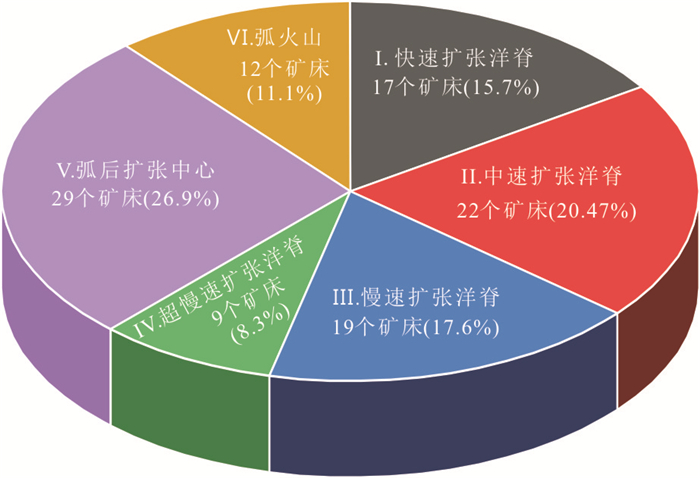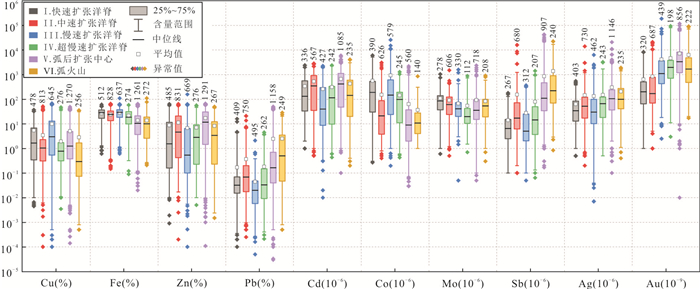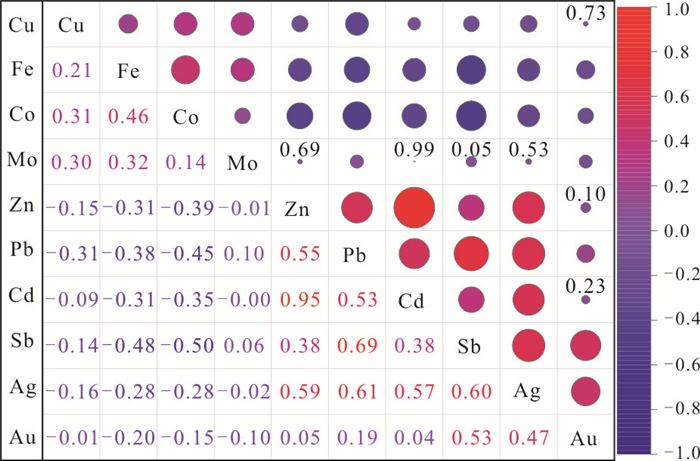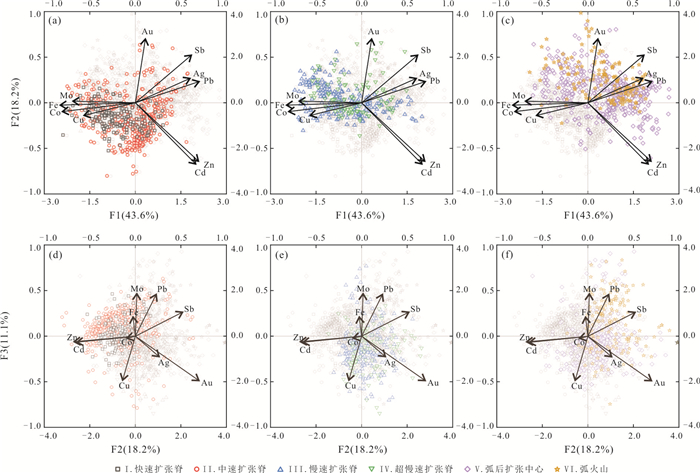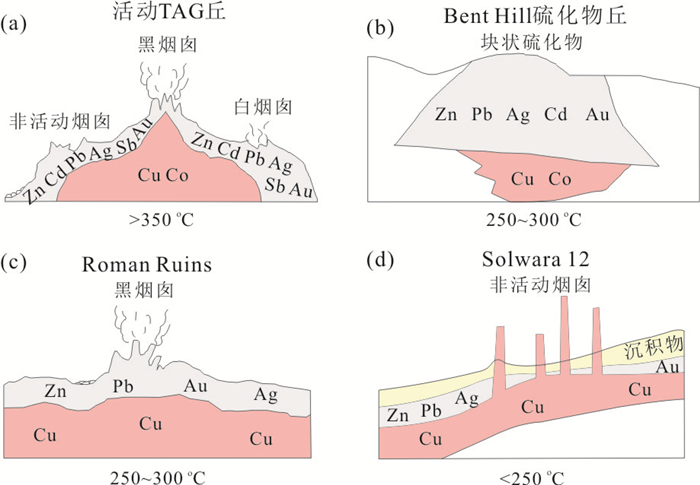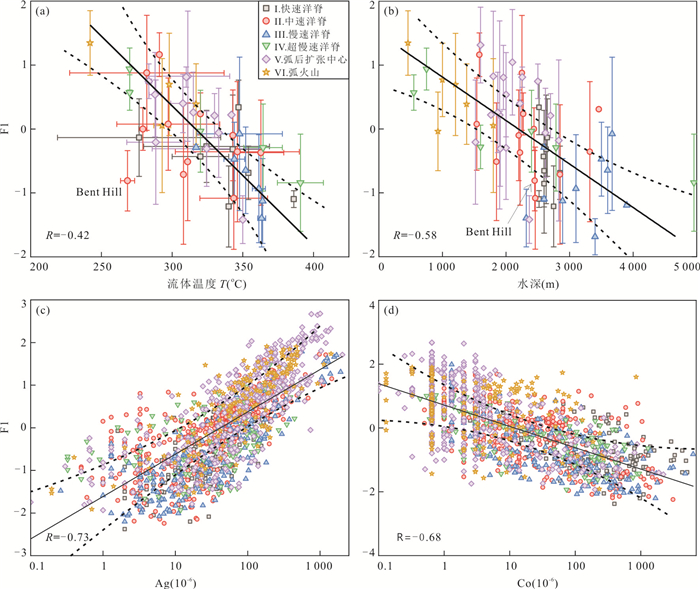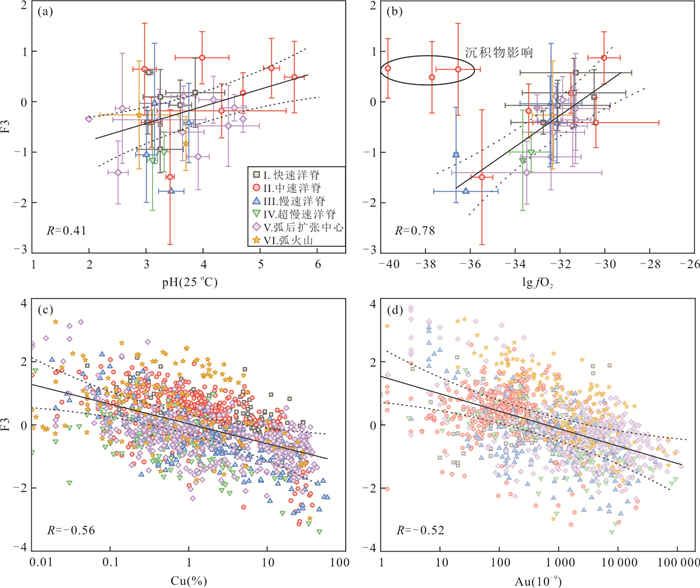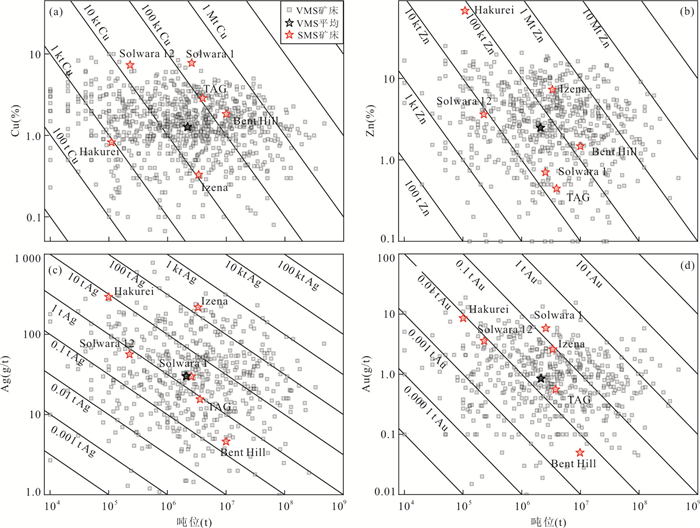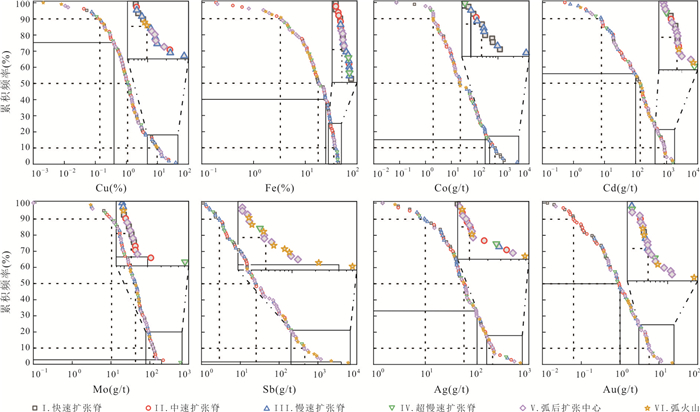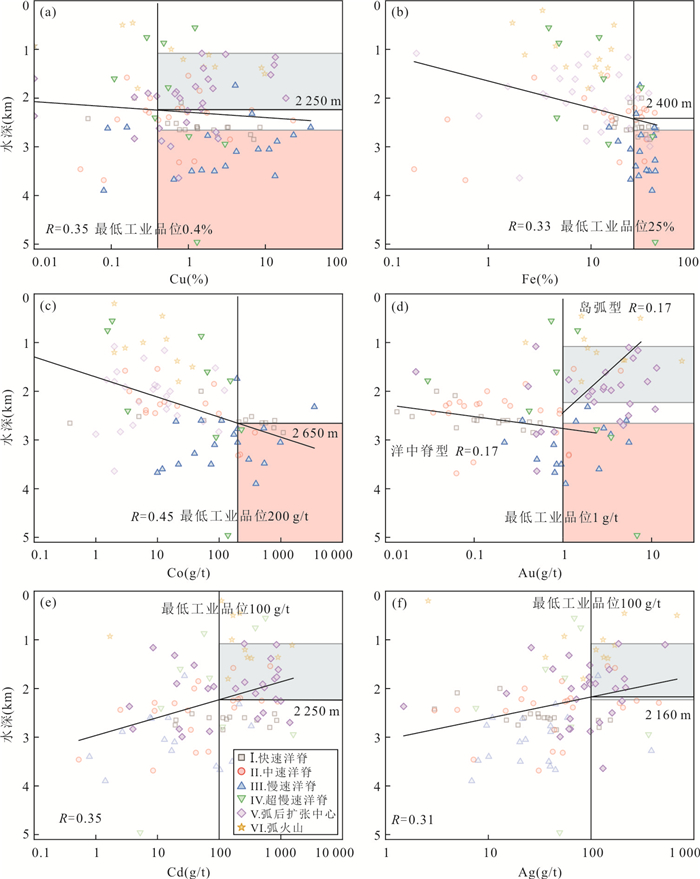Preliminary Study on the Enrichment Mechanism of Strategic Metals and Their Resource Prospects in Global Modern Seafloor Massive Sulfide Deposits
-
摘要: 海底块状硫化物(SMS)蕴藏有丰富的Cu、Cd、Au、Fe、Ag、Co等战略性金属,是未来可供人类开发利用的战略资源.本文搜集了全球3 946组SMS化学成分数据,根据构造环境可将其分成4类(快速、中速、慢速、超慢速扩张)洋中脊型和2类(弧后扩张中心和弧火山)岛弧型SMS矿床.利用多元统计方法分析了SMS战略性金属的分布特征和主控因素,探讨了其资源前景.结果表明:洋中脊型SMS矿床富集Cu+Fe+Co±Mo,而岛弧型普遍富集Zn+Pb+Cd+Sb+Ag±Au等关键元素.分析表明,成矿温度、成矿物质来源、酸碱度和氧化还原条件是战略性金属富集的主要影响因素,其中流体温度主要受水深条件控制,成矿物质来源主要受控于构造地质环境,酸碱度和氧化还原性主要受控于围岩类型.Cu+Au+Fe+Co在水深超过约2 650 m的慢速—超慢速扩张脊非转换不连续带和拆离断层带等区域具较好的勘查前景;而Cu+Au+Cd+Ag在水深约1 080~2 160 m的弧后扩张中心区域具较好的勘查前景.Abstract: Seafloor massive sulfides (SMS), which are rich in strategic metals such as Cu, Cd, Au, Fe, Ag, and Co, are strategic resources available for human development and utilization in the future. We collected the geochemical composition data of 3 946 SMS samples in global hydrothermal systems. They were classified into six types according to the tectonic setting: fast-spreading ridge type, medium-spreading ridge type, slow-spreading ridge type, ultra-slow spreading ridge type, back-arc spreading center type, and arc volcano type, respectively. The distribution and main controlling factors of SMS strategic metals are analyzed by multivariate statistical method, and then the resource prospects of SMS strategic metals are discussed. It is found that the strategic metals in SMS deposits of different tectonic environments are quite different. The SMS deposits at mid-ocean ridge tend to be enriched in Cu+Fe+Co±Mo, while the SMS deposits in the back-arc spreading center and arc volcano tend to be enriched in Zn+Pb+Cd+Sb+Ag±Au. The main controlling factors of SMS strategic metals are metallogenic temperature, ore-forming source, pH and redox conditions, respectively. The fluid temperature is mainly controlled by the water depth. The sources of ore-forming materials are mainly controlled by the structural geological environment. The pH and redox properties are mainly controlled by the type of wall rock. We propose that the back-arc spreading center with water depth of 1 080-2 160 m could be key targets for strategic metals such as Cu, Au, Cd and Ag, while the regions such as non-transform discontinuous and detachment fault extensional shear zone of slow- and ultraslow-spreading ridges with water depth greater than 2 650 m could be key targets for Cu, Au, Fe, Co, etc.
-
图 1 全球108个SMS矿床分布
海底扩张速率参考DeMets et al.(2010).单位矿石价值估值:按照美国联邦地质调查局2020年公布的金属价格和所选元素在各矿床的中值作为品位估算,据U.S. Geological Survey(2020).底图数据来自GEBCO Compilation Group (2020) GEBCO 2020 Grid (https://doi.org/10.5285/a29c5465-b138-234d-e053-6c86abc040b9),采用Goode等积投影
Fig. 1. Global distribution of 108 SMS deposits
图 6 现代SMS矿床结构简图
a. TAG矿床,据Lehrmann et al.(2018);b. Bent Hill矿床,据Zierenberg et al.(1998);c. Pacmanus/Roman Ruins矿床,据Petersen et al.(2005);d. Solwara 12矿床,据Lipton et al.(2018)
Fig. 6. Schematic cross sections of the modern SMS deposits
图 10 SMS矿床品位‒吨位关系
VMS矿床数据来自Mosier et al. (2009);SMS矿床数据同表 3
Fig. 10. Relation of grade-tonnage of SMS deposits
表 1 我国可能的及现代海底潜在的战略性金属对比
Table 1. List of possible "strategic metals" in China and the potential strategic metals on the seafloor
类别 战略性金属1 现代海底 多金属结核2 富钴结壳3 块状硫化物4 稀有金属 Li, Be, Nb, Ta, Rb, Sr, Zr, Hf, Cs Li, Zr Zr, Nb Sr 稀土金属 REE REE REE - 稀散金属 Ga, Ge, In, Tl, Cd, Se, Te, Re Tl Te, Tl Cd, Ga, Ge, In, Se, Te, Tl 稀贵金属 Os, Ir, Ru, Rh, Pd, Pt, Au, Ag Ru, Rh, Pd, Pt, Au, Ag Os, Ir, Ru, Rh, Pd, Pt, Au, Ag Au, Ag 能源金属 U - - - 其他 Fe, Cu, Al, Mn, Cr, V, Ti, Mg, Ni, Co, W, Sn, Bi, Mo, Sb, Hg, Se Fe, Mn, Ni, Cu, Co, Mo, W Fe, Mn, Co, Mo,
Bi, WCu, Fe, Bi, Hg, Co, Mo, Ti, Sb, Hg, Se 表 2 不同构造环境海底块状硫化物矿床浅表层样品战略性金属含量统计结果
Table 2. Element content of shallow samples collected from seafloor massive sulfide deposits located in different tectonic settings
构造环境 Ⅰ.快速扩张洋脊 Ⅱ.中速扩张洋脊 Ⅲ.慢速扩张洋脊 Ⅳ.超慢速扩张洋脊 Ⅴ.弧后扩张中心 Ⅵ.弧火山 全部 Cu (%) 中值 1.65 1.04 2.97 0.77 1.25 0.29 1.21 均值 5.43 3.42 9.85 1.94 5.06 2.84 5.20 75% 6.75 2.30 12.98 1.75 4.93 1.76 4.80 25% 0.34 0.31 0.55 0.32 0.38 0.07 0.32 N 478 813 645 276 1 270 256 3 738 Fe (%) 中值 28.3 23.9 29.3 18.7 10.4 10.0 19.8 均值 27.0 23.8 28.1 21.4 13.8 13.6 20.7 75% 36.6 33.1 37.9 31.2 21.1 19.1 31.3 25% 16.80 13.50 18.40 9.90 3.73 2.60 8.00 N 512 828 637 274 1 261 272 3 784 Zn (%) 中值 1.54 4.60 0.54 2.84 11.70 3.39 4.17 均值 8.74 11.30 6.81 7.08 17.10 8.18 11.60 75% 11.50 20.70 6.58 9.12 30.50 12.40 19.70 25% 0.16 0.43 0.10 0.23 1.45 0.25 0.31 N 485 831 669 276 1 291 267 3 819 Pb (%) 中值 0.03 0.07 0.02 0.03 0.17 0.50 0.06 均值 0.17 0.37 0.04 0.18 2.46 2.49 1.17 75% 0.07 0.20 0.05 0.15 0.70 3.47 0.26 25% 0.02 0.02 0.01 0.01 0.04 0.05 0.02 N 409 750 495 262 1 158 249 3 323 Cd (10‒6) 中值 133 347 40 115 420 144 209 均值 338 532 259 309 668 430 493 75% 557 913 297 328 1 115 575 804 25% 33.00 35.50 8.82 9.86 48.00 20.80 23.00 N 336 567 427 242 1 085 235 2 892 Co (10‒6) 中值 190.0 21.0 147.0 98.0 9.0 10.8 37.0 均值 565.0 152.0 925.0 142.0 63.6 36.4 365.0 75% 529.0 87.8 615.0 194.0 37.0 29.0 218.0 25% 30.00 3.85 24.00 11.30 2.00 4.00 6.00 N 390 626 579 245 560 140 2 540 Mo (10‒6) 中值 85.0 61.0 41.0 19.8 35.5 53.5 48.0 均值 108.0 90.6 67.0 54.2 92.1 82.2 87.2 75% 139 123 73 43 97 99 106 25% 38.0 24.0 20.0 11.0 15.0 19.6 19.0 N 278 606 330 112 718 208 2 252 Sb (10‒6) 中值 6.5 17.0 5.0 14.4 110.0 222.0 31.0 均值 14.1 153.0 27.5 79.1 852.0 1 387.0 474.0 75% 15.0 71.5 25.0 52.5 469.0 898.0 150.0 25% 2.55 6.33 2.09 3.83 34.40 70.00 7.10 N 267 680 312 207 907 240 2 613 Ag (10‒6) 中值 33.9 52.0 30.0 66.0 105.0 100.0 62.0 均值 63.1 145.0 133.0 149.0 300.0 206.0 193.0 75% 83.5 121.0 100.0 122.0 240.0 272.0 163.0 25% 13.5 17.3 10.2 19.6 36.6 41.0 20.0 N 403 730 462 243 1 146 235 3 219 Au (10‒9) 中值 200 170 1 100 1 965 3 370 1 685 970 均值 641 844 4 110 4 639 7 163 6 294 4 054 75% 506 770 3 662 3 770 8 250 4 765 3 738 25% 66.8 70.0 430.0 705.0 1 200.0 471.0 178.0 N 320 687 439 198 856 222 2 722 注:N为分析的样品数,表中元素含量未统计其样品的大小. 表 3 全球已钻探SMS矿床的品位和吨位
Table 3. The grade and tonnage of SMS deposits in world's oceans obtained by drilling
矿床 区域 钻孔数(个) 总长(m) 吨位(Mt) Cu (%) Zn (%) Pb (%) Ag (g/t) Au (g/t) Bent Hill1 胡安德富卡脊 7 1 918 10~15 1.65 1.29 0.008 3 4.48 0.05 TAG2 北大西洋脊 5 304 3.9 2.83 0.42 0.006 5 14.0 0.534 Izena3 冲绳海槽 176 3 785 7.4 0.41 5.75 1.44 95.6 1.45 Hakurei3 伊豆小笠原岛弧 41 405 0.1 0.82 15.84 1.30 294.2 8.63 Solwara 14 帕克马努斯海盆 247 2 779 2.6 7.74 0.7 ‒ 29.59 5.84 Solwara 124 帕克马努斯海盆 28 329 0.2 7.3 3.6 ‒ 56 3.6 注:1 Fouquet et al.(1998) 、Zierenberg et al.(1998) ;2Hannington et al.(1998) ;3 JOGMEC官网(海底热液矿床开发计划综合评价报告书);4Lipton et al.(2018) . -
Cathles, L. M., 2011. What Processes at Mid-Ocean Ridges Tell Us about Volcanogenic Massive Sulfide Deposits. Mineralium Deposita, 46(5-6): 639-657. https://doi.org/10.1007/s00126-010-0292-9 Charlou, J. L., Donval, J. P., Konn, C., et al., 2010. High Production and Fluxes of H2and CH4and Evidence of Abiotic Hydrocarbon Synthesis by Serpentinization in Ultramafic-Hosted Hydrothermal Systems on the Mid-Atlantic Ridge. In: Rona, P. A., Devey, C. W., Dyment, J., et al., eds., Diversity of Hydrothermal Systems on Slow Spreading Ocean Ridges. American Geophysical Union, Washington, D. C. . Chen, Y., Han, X. Q., Wang, Y. J., et al., 2020. Precipitation of Calcite Veins in Serpentinized Harzburgite at Tianxiu Hydrothermal Field on Carlsberg Ridge (3.67°N), Northwest Indian Ocean: Implications for Fluid Circulation. Journal of Earth Science, 31(1): 91-101. https://doi.org/10.1007/s12583-020-0876-y de Ronde, C. E. J., Massoth, G. J., Butterfield, D. A., et al., 2011. Submarine Hydrothermal Activity and Gold-Rich Mineralization at Brothers Volcano, Kermadec Arc, New Zealand. Mineralium Deposita, 46(5-6): 541-584. https://doi.org/10.1007/s00126-011-0345-8 DeMets, C., Gordon, R. G., Argus, D. F, 2010. Geologically Current Plate Motions. Geophysical Journal International, 181(1): 1-80. https://doi.org/10.1111/j.1365-246X.2009.04491.x Egozcue, J. J., Pawlowsky-Glahn, V., Mateu-Figueras, G., et al., 2003. Isometric Logratio Transformations for Compositional Data Analysis. Mathematical Geology, 35(3): 279-300. https://doi.org/10.1023/A:1023818214614 Fouquet, Y., Cambon, P., Etoubleau, J., et al., 2010. Geodiversity of Hydrothermal Processes along the Mid-Atlantic Ridge and Ultramafic-Hosted Mineralization: A New Type of Oceanic Cu-Zn-Co-Au Volcanogenic Massive Sulfide Deposit. In: Rona, P. A., Devey, C. W., Dyment, J., et al., eds., Diversity of Hydrothermal Systems on Slow Spreading Ocean Ridges. American Geophysical Union, Washington, D. C. . Fouquet, Y., Zierenberg, R. A., Miller, D. J., et al., 1998. Shipboard Scientific Party, Middle Valley: Bent Hill Area (Site 1035). In: Fouquet, Y., Zierenberg, R. A., Miller, D. J., et al., eds., Proceedings of the Ocean Drilling Program-Initial Reports 169. The Ocean Drilling Program, College Station. Fuchs, S., Hannington, M. D., Petersen, S., 2019. Divining Gold in Seafloor Polymetallic Massive Sulfide Systems. Mineralium Deposita, 54(6): 789-820. https://doi.org/10.1007/s00126-019-00895-3 Graedel, T. E., Harper, E. M., Nassar, N. T., et al., 2015. Criticality of Metals and Metalloids. PNAS, 112(14): 4257-4262. https://doi.org/10.1073/pnas.1500415112 Hannington, M. D., 2014. Volcanogenic Massive Sulfide Deposits. Treatise on Geochemistry, 47(5): 463-488. https://doi.org/10.1016/b978-0-08-095975-7.01120-7 Hannington, M. D., de Ronde, C. E., Petersen S., 2005. Sea-Floor Tectonics and Submarine Hydrothermal Systems. In: Hedenquist, J., Thompson, G., Goldfarb, R. J., Richards, J. P., eds., Economic Geology 100th Anniversary Volume. Society of Economic Geologists, Littleton Hannington, M. D., Galley, A. G., Herzig, P. M., et al., 1998. Comparison of the TAG Mound and Stockwork Complex with Cyprus-Type, Massive Sulfide Deposits. In: Herzig, P. M., Humphris, S. E., Miller, D. J., et al., eds., Proceedings of the Ocean Drilling Program-Scientific Results. The Ocean Drilling Program, College Station. Hannington, M. D., Jamieson, J., Monecke, T., et al., 2011. The Abundance of Seafloor Massive Sulfide Deposits. Geology, 39(12): 1155-1158. https://doi.org/10.1130/g32468.1 Hannington, M. D., Petersen, S., Herzig, P. M., et al., 2004. A Global Database of Seafloor Hydrothermal Systems, Including a Digital Database of Geochemical Analyses of Seafloor Polymetallic Sulfides. Geological Survey of Canada, Ottawa. Hein, J. R., Mizell, K., Koschinsky, A., et al., 2013. Deep-Ocean Mineral Deposits as a Source of Critical Metals for High- and Green-Technology Applications: Comparison with Land-Based Resources. Ore Geology Reviews, 51: 1-14. https://doi.org/10.1016/j.oregeorev.2012.12.001 Kawasumi, S., Chiba, H., 2017. Redox State of Seafloor Hydrothermal Fluids and Its Effect on Sulfide Mineralization. Chemical Geology, 451: 25-37. https://doi.org/10.1016/j.chemgeo.2017.01.001 Large, R. R., 1992. Australian Volcanic-Hosted Massive Sulfide Deposits; Features, Styles, and Genetic Models. Economic Geology, 87(3): 471-510. https://doi.org/10.2113/gsecongeo.87.3.471 Lehrmann, B., Stobbs, I. J., Lusty P. A., et al., 2018. Insights into Extinct Seafloor Massive Sulfide Mounds at the TAG, Mid-Atlantic Ridge. Minerals, 8(7): 302. https://doi.org/10.3390/min8070302 Levin, L. A., Amon, D. J., Lily, H, 2020. Challenges to the Sustainability of Deep-Seabed Mining. Nature Sustainability, 3(10): 784-794. https://doi.org/10.1038/s41893-020-0558-x Lipton, I., Gleeson, E., Munro, P., 2018. Preliminary Economic Assessment of the Solwara Project, Bismarck Sea, PNG. Nautilus Minerals Niugini Limited, Vancouver. Lusty, P. A. J., Hein, J. R., Josso, P., 2018. Formation and Occurrence of Ferromanganese Crusts: Earth's Storehouse for Critical Metals. Elements, 14(5): 313-318. https://doi.org/10.2138/gselements.14.5.313 Mao, J. W., Yang, Z. X., Xie, G. Q., et al., 2019. Critical Minerals: International Trends and Thinking. Mineral Deposits, 38(4): 689-698 (in Chinese with English abstract). http://en.cnki.com.cn/Article_en/CJFDTotal-KCDZ201904001.htm Melekestseva, I. Y., Maslennikov, V. V., Tret'yakov, G. A., et al., 2017. Gold- and Silver-Rich Massive Sulfides from the Semenov-2 Hydrothermal Field, 13°31.13'N, Mid-Atlantic Ridge: A Case of Magmatic Contribution? Economic Geology, 112(4): 741-773. https://doi.org/10.2113/econgeo.112.4.741 Monecke, T., Petersen, S., Hannington, M. D., 2014. Constraints on Water Depth of Massive Sulfide Formation: Evidence from Modern Seafloor Hydrothermal Systems in Arc-Related Settings. Economic Geology, 109(8): 2079-2101. https://doi.org/10.2113/econgeo.109.8.2079 Monecke, T., Petersen, S., Hannington, M. D., et al., 2016. The Minor Element Endowment of Modern Sea-Floor Massive Sulfides and Comparison with Deposits Hosted in Ancient Volcanic Successions. In: Verplanck, P. L., Hitzman, M. W., eds., Rare Earth and Critical Elements in Ore Deposits. Society of Economic Geologists, Littleton. Mosier, D. L., Berger, V. I., Singer, D. A., 2009. Volcanogenic Massive Sulfide Deposits of the World; Database and Grade and Tonnage Models. U.S. Geological Survey, Reston. Murton, B. J., Lehrmann, B., Dutrieux, A. M., et al., 2019. Geological Fate of Seafloor Massive Sulphides at the TAG Hydrothermal Field (Mid-Atlantic Ridge). Ore Geology Reviews, 107: 903-925. https://doi.org/10.1016/j.oregeorev.2019.03.005 Padyar, F., Rahgoshay, M., Tarantola, A., et al. 2020. High ƒH2-ƒS2 Conditions Associated with Sphalerite in Latala Epithermal Base and Precious Metal Deposit, Central Iran: Implications for the Composition and Genesis Conditions of Sphalerite. Journal of Earth Science, 31(3): 523-535. https://doi.org/10.1007/s12583-019-1023-6 Pak, S. J., Seo, I., Lee, K. Y., et al., 2019. Rare Earth Elements and Other Critical Metals in Deep Seabed Mineral Deposits: Composition and Implications for Resource Potential. Minerals, 9(1): 3-22. https://doi.org/10.3390/min9010003 Petersen, S., Herzig, P. M., Kuhn, T., et al., 2005. Shallow Drilling of Seafloor Hydrothermal Systems Using the BGS Rockdrill: Conical Seamount (New Ireland Fore-Arc) and PACMANUS (Eastern Manus Basin), Papua New Guinea. Marine Georesources & Geotechnology, 23(3): 175-193. https://doi.org/10.1080/10641190500192185 Petersen, S., Lehrmann, B., Murton, B. J., 2018. Modern Seafloor Hydrothermal Systems: New Perspectives on Ancient Ore-Forming Processes. Elements, 14(5): 307-312. https://doi.org/10.2138/gselements.14.5.307 Toffolo, L., Nimis, P., Tretyakov, G. A., et al., 2020. Seafloor Massive Sulfides from Mid-Ocean Ridges: Exploring the Causes of Their Geochemical Variability with Multivariate Analysis. Earth-Science Reviews, 201: 102958. https://doi.org/10.1016/j.earscirev.2019.102958 U.S. Geological Survey, 2020. Mineral Commodity Summaries 2020. U.S. Geological Survey, Reston. Wang, D. H., 2019. Study on Critical Mineral Resources: Significance of Research, Determination of Types, Attributes of Resources, Progress of Prospecting, Problems of Utilization, and Direction of Exploitation. Acta Geologica Sinica, 93(6): 1189-1209 (in Chinese with English abstract). Wang, Y. J., Han, X. Q., Petersen, S., et al., 2014. Mineralogy and Geochemistry of Hydrothermal Precipitates from Kairei Hydrothermal Field, Central Indian Ridge. Marine Geology, 354: 69-80. https://doi.org/10.1016/j.margeo.2014.05.003 Yang, K., Scott, S. D., 2006. Magmatic Fluids as a Source of Metals in Seafloor Hydrothermal Systems. In: Christie, D. M., Fisher, C. R., Lee, S. M., et al., eds., Back-Arc Spreading Systems: Geological, Biological, Chemical, and Physical Interactions. American Geophysical Union, Washington, D. C. . Zierenberg, R. A., Fouquet, Y., Miller, D. J., et al., 1998. The Deep Structure of a Sea-Floor Hydrothermal Deposit. Nature, 392(6675): 485-488. https://doi.org/10.1038/33126 毛景文, 杨宗喜, 谢桂青, 等, 2019. 关键矿产: 国际动向与思考. 矿床地质, 38(4): 689-698. https://www.cnki.com.cn/Article/CJFDTOTAL-KCDZ201904001.htm 王登红, 2019. 关键矿产的研究意义、矿种厘定、资源属性、找矿进展、存在问题及主攻方向. 地质学报, 93(6): 1189-1209. doi: 10.3969/j.issn.0001-5717.2019.06.003 -
 dqkxzx-46-9-3123-附录B.xlsx
dqkxzx-46-9-3123-附录B.xlsx

 dqkxzx-46-9-3123-附表1.xlsx
dqkxzx-46-9-3123-附表1.xlsx

 dqkxzx-46-9-3123-附录A.docx
dqkxzx-46-9-3123-附录A.docx

 dqkxzx-46-9-3123-附表2.xlsx
dqkxzx-46-9-3123-附表2.xlsx

-









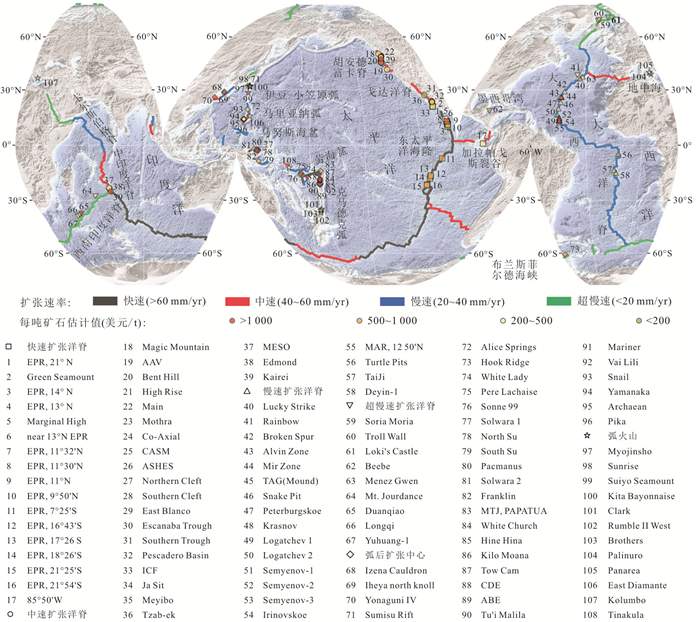
 下载:
下载:
